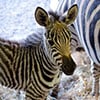You can find three different species of zebra in the wild, namely Plains zebra, mountain zebra and Grevy’s zebra.
Here at Flamingo Land we have Grant’s zebras, which are a subspecies of Plains zebra, and in fact the smallest one found. They can be found living in central and southern Africa, in countries such as Kenya, Tanzania and Zambia, where their natural habitat is grassland and savannah woodland. Although plains zebras are not endangered like the other two species, some populations such as those in Tanzania have seen significant declines in their numbers, mostly due to hunting for their meat and hide and conversion of their habitats into farmland.
Grant’s zebras have vertical stripes on their front, horizontal stripes on their back legs and diagonal stripes in between. These patterns are unique to each zebra, almost like a fingerprint, so can be used to identify individual animals. Scientists think that the bright black and white stripes evolved to confuse predators when they bunch together in a herd, making it difficult for them to tell how many there are and which direction they’re going. Zebras will therefore keep watch for predators rather than attempting to hide from them, and if cornered will kick out and bite with sharp hooves and teeth. With enough warning though, they can run at speeds of up to 40mph!
Wild zebras live in family groups, which are usually led by a dominant male (or stallion) who will help to keep them safe. Zebra foals can stand up almost immediately after they are born, similar to other prey species who must be able to escape from predators from a very young age. They will start eating grass within a week but aren’t fully weaned until 7-11 months old, and will disperse from the group at 1-3 years. Young males will often group together in “bachelor herds” until they are old enough to compete for females – usually at about 4 years old. Although they look like horses, they don’t neigh, and instead make a barking noise. They can also communicate with each other using facial expressions and body movements.
ConservationStatus
Least Concerned
Near Threatened
Vulnerable
Endangered
Critically Endangered
Extinct In The Wild

